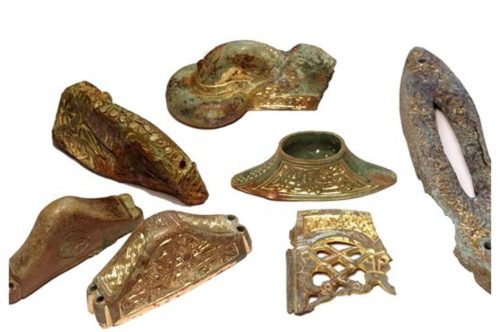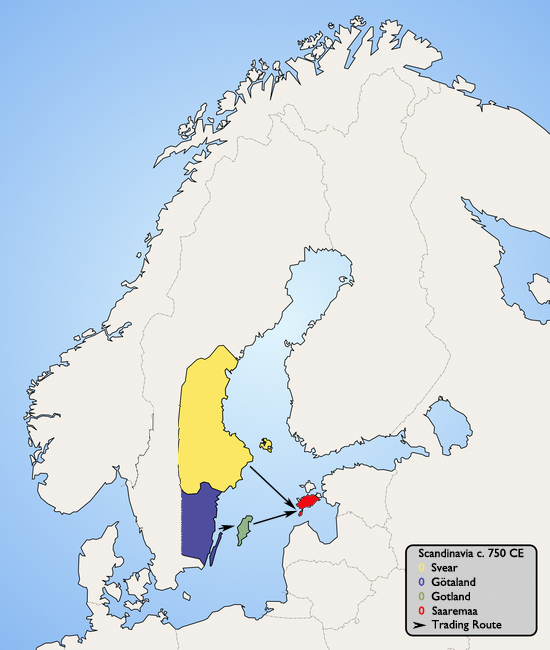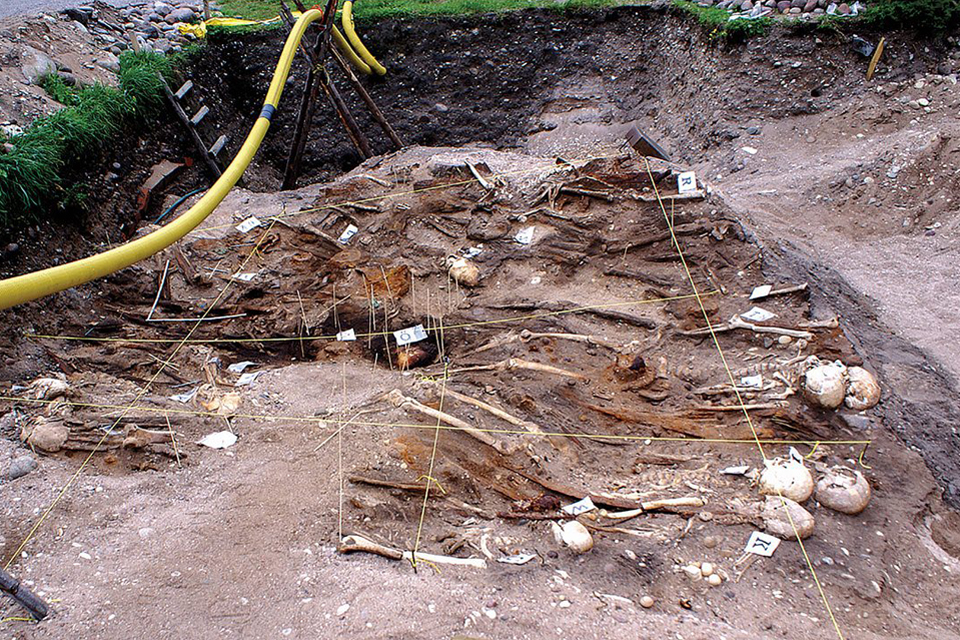Around 750 CE 41 individuals were buried in two Viking ships at Salme in Estonia. New studies tell us much about who they were, where they came from and why they sailed across the Baltic.
In 2008, workers stumbled upon a burial ground full of human skeletons, iron swords, rivets, bone gaming pieces and other finds. Archaeologists were luckily called to the site in time to carry out a proper archaeological excavation of what later turned out to be a very important site. The objects could be dated to AD 750, more precisely the end of the vendel Age and the beginning of the Viking Age. None of the artefacts could stylistically be placed in an Estonian context, rather they featured a style associated with Scandinavia. During the excavations, the remains of two ships were uncovered. These ships had been dragged approximately a hundred meter inland and afterwards partly covered with stones and soil.
The Ships

The ships were clinker built. One had unfortunately been partly destroyed by the building activities. However, it was probably a rowing boat with six pairs of oars, measuring 11.5 metres. In this boat were found seven skeletons of tall, young men buried together with two swords, spear- and arrowheads, knives, a small axe, fragments of combs made of deer antler and 75 gaming pieces made of whale and cattle bone. The remains of bones from pigs, sheep, goats and cattle bones witnessed to the funeral feast, which the survivors of the party may have held. Heads of two decapitated hawks indicate that the party of young men in all likelihood belongs to the elite.
Two years later, archaeologists found another ship (Salme II) 30 – 50 meters south of the first. Here the archaeologists came upon a scene, which was much less orderly. Marks on the skeletons showed that these men had taken part in vicious skirmish. All in all 34 individuals were found in the ship which was later calculated to have measured 17 – 17.5 metres long and 3 metres wide. The ship had a keel, indicating that it had been fitted with a mast and sail. This boat is estimated to have carried a crew of around thirty. If both ships had been fully manned, max five would have escaped the final fighting. This helps to explain the different character of the two ship burials; while one was orderly, the other held 34 skeletons stacked in four layers on the ship as if it were firewood. The bodies had been buried with 40 swords and covered with their shields and cloth from the sail. Other grave goods consisted of pendants of bear canines, beads, broken shears, ornamented combs, small padlocks and gaming pieces. A large number of arrowheads were found scattered around, probably major contribution to the death of the buried persons. Ample evidence of the traumatic death, they had suffered, was easy to detect.
The People
 After excavation of the Salme ship burials, the archaeologists carried out systematic studies of the skeletons as well as isotopic analysis. Three individuals from Salme I and five from Salme II had their molars extracted in order to analyse the enamel, which forms between 1.5 and 7 years of age. The study was carried out to find evidence for mobility since childhood. The conclusion was that the buried individuals had not come from Salme, or the further Eastern Baltic. Rather the results were “not inconstant with values from the Stockholm region”, but slightly higher than what might be expected from Gotland. This fitted well with the results of a closer study of the grave goods, which showed that the sword hilts and scabbards had close parallels in the Vendel and Valsgärde burials near Uppsala as well as further up in Finland. It is likely that a number of the prestigious goods found on Salme may have been made at the centre at Helgö. The numerous luxurious “play-things” – the 326 gaming pieces, the two hawks and a dog – indicate that the ships were part of a diplomatic mission rather than representing a raiding party. It is probable that the party belonged to the Svears, who came from the northern region around Lake Mälaren and that they had travelled to Salme in order to establish trading relations with the Estonians.
After excavation of the Salme ship burials, the archaeologists carried out systematic studies of the skeletons as well as isotopic analysis. Three individuals from Salme I and five from Salme II had their molars extracted in order to analyse the enamel, which forms between 1.5 and 7 years of age. The study was carried out to find evidence for mobility since childhood. The conclusion was that the buried individuals had not come from Salme, or the further Eastern Baltic. Rather the results were “not inconstant with values from the Stockholm region”, but slightly higher than what might be expected from Gotland. This fitted well with the results of a closer study of the grave goods, which showed that the sword hilts and scabbards had close parallels in the Vendel and Valsgärde burials near Uppsala as well as further up in Finland. It is likely that a number of the prestigious goods found on Salme may have been made at the centre at Helgö. The numerous luxurious “play-things” – the 326 gaming pieces, the two hawks and a dog – indicate that the ships were part of a diplomatic mission rather than representing a raiding party. It is probable that the party belonged to the Svears, who came from the northern region around Lake Mälaren and that they had travelled to Salme in order to establish trading relations with the Estonians.
It is likely, the Svears here met up with some of their southern neighbours from Götaland off the coast of Gotland. They patrolled the Southern maritime route across the Baltic and continued to be competitors and born enemies of the Svears from further north. The reason is that after the battle, a few survivors were able to accomplish the feat of hauling the ships inland in order to bury their fallen comrades. Had the ambush been perpetrated by local Oeselians – the Estonian inhabitants – it is unlikely that the survivors had been able to carry this feat out in peace. Also, it is unlikely the swords and the other valuables would not have been looted.
The archaeologists conclude that the ships from Salme witness to a sophisticated political landscape governing trade and other relationships across the Baltic around 750 CE.
SOURCE:
Isotopic provenancing of the Salme ship burials in Pre-Viking Age Estonia
By T. Douglas Price Jüri Peets, Raili Allmäe, Liina Maldre and Ester Oras
In. Antiquity (2016), Vol 90, pp. 1022 – 1037
FEATURED PHOTO:
Excavations at Salme in Estonia Photo: Railli Allmae
